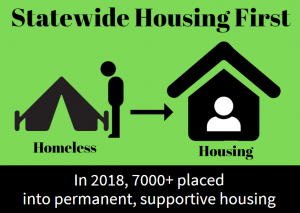Helping the homeless find hope, housing statewide
Posted on Mar 25, 2019 in Capitol Connection, Featured, Main
“The things we’ve done aren’t flashy, but we’re getting results and keeping people from just cycling through the system,” Morishige said. “The fact that we placed an average of 584 people a month into housing in 2018 is a huge thing. With our emphasis on Housing First, we’re providing people with short-term assistance so they can stabilize their situation. The goal is to make sure they stay housed and not fall back into homelessness.”
So what about the homeless we still see in tents on the street? Morishige said he’s working with Lt. Gov. Josh Green on new ways to help the chronically homeless, especially those with complex medical challenges, including mental health issues and substance abuse. “That’s where it’s helpful to partner with an emergency room doctor like the lieutenant governor,” Morishige said. The Ige administration is also planning for “‘ohana zones” that would include expanded emergency shelter space and supportive, short-term housing and services for the chronically homeless, using the $30 million appropriated by the Legislature last year.
Morishige admits that it’s difficult to explain to the average person why anyone would choose to live in a tent instead of being in a shelter. “Trust is a major issue for the homeless people we’re working with,” he explained. “It’s hard for some of them to plan long-term when they’re dealing with an open wound or other emergency. They’re also worried about losing what little control they have over their own lives. That’s why we need to get them stabilized so they’re ready to accept our help.”
The Ige administration’s Housing First approach is working, Morishige said. The percentage of people finding housing has increased from one-third to over 50 percent. And for the second consecutive year, O‘ahu’s total number of homeless individuals has decreased, according to the 2019 Point in Time count. (The neighbor island count will be released separately.) “Last year, over 4,400 people on O‘ahu moved from homelessness to permanent housing,” Governor Ige emphasized. “Our end goal of helping people find housing continues to produce results and shows that by working together, we’re making a difference.”